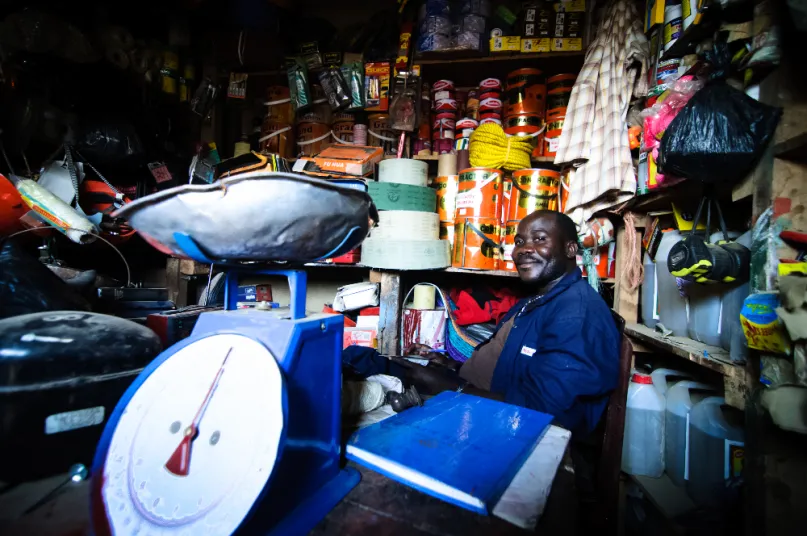Formalizing Remittances for Forcibly Displaced People: Findings from the Democratic Republic of the Congo

The Democratic Republic of the Congo (DRC) is home to 10 percent of the world’s entire population of internally displaced people – the largest such situation in Africa, with an estimated 5 million people. The DRC also hosts more than half a million refugees and asylum seekers from neighboring countries. In this context of forced displacement, access to formal financial services is uncommon. At just over 10 percent of the adult (15 years or older) population, the rate of bank account ownership is three times lower than the level of access across sub-Saharan Africa.
The state of remittances in the DRC
Remittances, however, are important for the country, and could provide a key opportunity to advance financial inclusion. The value of remittances for the population of the DRC as a whole, while difficult to ascertain, has been estimated by the World Bank at $1.8 billion in 2019, or 3.7 percent of the country’s GDP.
A recent study commissioned by the United Nations High Commissioner for Refugees (UNHCR) and the United Nations Capital Development Fund (UNCDF) shows an untapped potential for remittance service providers to reach forcibly displaced people in the DRC. For the study, we interviewed 656 households across four provinces, exploring remittance usage by people based in refugee camps and the host communities and rural areas around them, among some other locations.
43 percent of respondents reported sending or receiving remittances, and the average annual amount sent or received was nearly $95. Half of the transactions were in cash. Another study on DRC remittances by FinMark Trust from 2018 estimated that 81 percent of remittances were informal, whether through the physical delivery of cash or goods or via grassroots networks of unregulated agents.
Shifting to formal remittance channels
With 5 million internally displaced people in the DRC, the potential annual volume for this market runs into tens of millions of dollars that could be shifted into formal remittance channels and then possibly linked to a broader suite of products—savings, insurance, and more—with real implications for financial inclusion. So how could this shift happen?
Forcibly displaced persons must be incorporated into national financial inclusion strategies, and those strategies must emphasize expansion of formal and affordable remittance services which can in turn help displaced persons become self-reliant and make economic contributions to their communities. Connectivity for refugees is also key in making sure that they can gain access to other formal financial services. For their part, . For example, our study’s respondents indicated that affordability and speed were most important to them when choosing remittance service providers, prioritizing those qualities over others such as convenience or usability.
Through our research for this study, we have analyzed the measures available and we advocate the following actions for government, financial institutions and regulators to make remittances work for forcibly displaced people in the DRC.
- Governments should provide universal access to the digital payment infrastructure, including enforcement of an open USSD (unstructured supplementary service data) channel for all types of financial services. USSD is must-have technology for financial inclusion through mobile phones, as it transmits information through network channels normally used for voice calls or texts, allowing those channels to support other functions including financial transactions.
- Regulators should allow international money transfers via mobile phones and should also encourage stand-alone bank agents (who perform the function of converting those digital transfers into physical cash) to hire and train forcibly displaced people to work in this role.
- Regulators and financial service providers should collaborate on a range of issues so that:
- Financial service providers understand which ID documents the government requires for forcibly displaced customers to access various types of financial services.
- Financial service providers have a roadmap to guide them through regulatory approval of various forms of partnerships (e.g., between mobile money operators and between money transfer operators and local transfer agents).
- Agents have the necessary understanding of all relevant regulations, have the proper incentives, and have been properly trained to see and treat forcibly displaced persons as legitimate customers.
- Financial service providers understand which ID documents the government requires for forcibly displaced customers to access various types of financial services.
- Remittance service providers should consider partnerships with humanitarian agencies and others, to provide an attractive international transfer product which gives refugees a safe way to receive money from abroad.
- All stakeholders should work to create more awareness of formal channels among the internally displaced, as well as among cross-border refugees, and to demonstrate the benefits of those channels.
Remittances are a lifeline to refugees, forcibly displaced people and poor households in the DRC – particularly during the COVID-19 pandemic, but also beyond.


